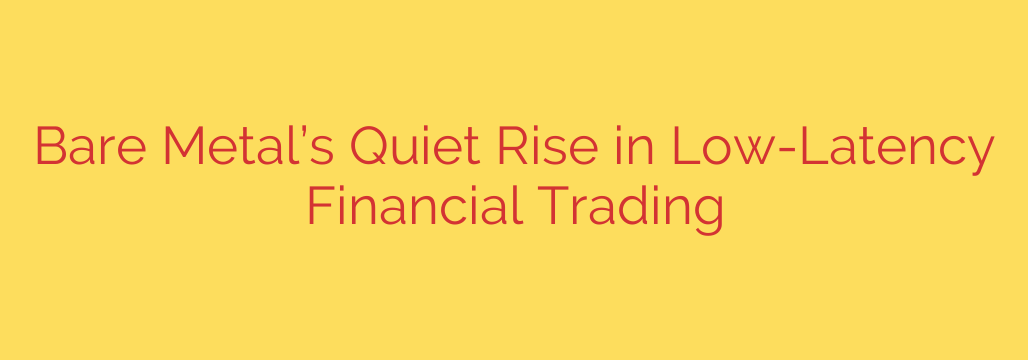
The Edge in Milliseconds: Why Bare Metal Dominates Low-Latency Financial Trading
In the world of high-stakes financial trading, fortunes are made or lost in the time it takes to blink. Even a delay of a few milliseconds can mean the difference between a profitable arbitrage opportunity and a significant loss. While the cloud has revolutionized countless industries, a more traditional and powerful solution has reasserted its dominance in the ultra-competitive fintech space: bare metal servers.
For trading firms engaged in high-frequency trading (HFT), algorithmic strategies, and market making, minimizing latency is not just a goal—it is the entire game. This relentless pursuit of speed is why many are turning, or returning, to dedicated physical servers to gain a critical performance edge.
What Exactly is a Bare Metal Server?
Before diving into the “why,” let’s clarify the “what.” A bare metal server is a physical computer server dedicated entirely to a single tenant or user. Unlike virtualized environments or public cloud instances, there is no hypervisor layer—the software that creates and runs virtual machines (VMs).
With bare metal, you get direct, unfiltered access to all of the server’s physical resources, including the processor, memory, storage, and network controllers. It’s the digital equivalent of having a high-performance engine all to yourself, without any governors or shared components slowing you down.
The Unbeatable Advantages of Bare Metal in Trading
The decision to use bare metal infrastructure is driven by a clear set of benefits that directly address the core challenges of low-latency trading.
1. Raw, Uncompromised Performance
In a virtualized cloud environment, the hypervisor consumes a portion of the server’s resources to manage its VMs. This layer, while efficient for general computing, introduces a small but critical amount of overhead and latency.
For financial trading, eliminating the hypervisor layer gives applications direct access to the hardware, resulting in the lowest possible processing time. Every CPU cycle is dedicated to running the trading algorithm, ensuring that market data is analyzed and orders are executed with maximum speed.
2. Predictable and Consistent Latency
Perhaps the biggest drawback of shared cloud environments is the “noisy neighbor” effect. When another user on the same physical hardware runs a resource-intensive process, it can temporarily slow down your own applications, creating unpredictable latency spikes. In trading, unpredictability is poison.
Bare metal provides a completely isolated environment, ensuring consistent and predictable performance. Your trading application’s latency won’t be affected by the activities of other tenants because there are no other tenants. This reliability allows firms to build and calibrate their strategies with confidence, knowing their infrastructure will perform the same way every time.
3. Enhanced Security and Control
Handling sensitive financial data and proprietary trading algorithms demands the highest level of security. With a single-tenant bare metal server, you have complete control over your environment.
This physical isolation offers a fundamentally more secure foundation than multi-tenant virtual servers. There is no risk of cross-VM vulnerabilities or data leakage through a compromised hypervisor. Firms can implement their own security protocols, custom operating systems, and kernel-level optimizations without the restrictions imposed by a cloud provider. This level of control is also crucial for meeting strict regulatory and compliance requirements.
4. Granular Customization for a Competitive Edge
High-frequency trading isn’t a one-size-fits-all discipline. Firms often require highly specialized hardware to get an edge. This can include specialized network interface cards (NICs), field-programmable gate arrays (FPGAs) for hardware-accelerated processing, and precision timing cards.
Bare metal allows for deep hardware customization that is simply not possible in most public cloud environments. This ability to fine-tune the physical machine for a specific trading strategy is a powerful differentiator that can yield significant performance gains.
The Critical Role of Colocation
A fast server is only part of the equation. The other half is proximity. The speed of light is a hard physical limit, and the distance data must travel to and from a financial exchange is a major source of latency.
This is why bare metal servers used for trading are almost always housed in colocation data centers. These facilities are strategically located in the same building or campus as the major financial exchanges, such as those in New York (NY4/NY5), London (LD4), and Tokyo (TY3). By placing servers just meters away from an exchange’s matching engine, firms can reduce network latency to mere microseconds.
Actionable Security Tips for Bare Metal Trading Infrastructure
While inherently secure, deploying a bare metal environment still requires a robust security posture.
- Choose a Reputable Data Center: Ensure the colocation facility has stringent physical security controls, including biometric access, 24/7 monitoring, and secured cages.
- Implement Network Segmentation: Use dedicated firewalls and network segmentation to isolate your trading infrastructure from other networks, both internal and external.
- Harden the Operating System: Strip down the OS to its essential components to reduce the attack surface. Apply security patches promptly and enforce strict access controls.
- Leverage Dedicated DDoS Protection: Given the high stakes, trading infrastructure is a prime target for Distributed Denial-of-Service (DDoS) attacks. Use a specialized DDoS mitigation service to ensure uptime.
The Final Word: A Non-Negotiable Standard
While the cloud offers incredible flexibility and scalability for countless business applications, the unique demands of low-latency financial trading place it in a category of its own. For firms where every microsecond counts, the raw power, predictable performance, and deep control of bare metal infrastructure are non-negotiable.
It’s a quiet but powerful trend, proving that in the race to zero latency, the most direct path to the hardware is still the fastest. For elite trading operations, bare metal isn’t just a choice; it’s the standard.
Source: https://www.datacenters.com/news/financial-services-are-quietly-choosing-bare-metal-for-low-latency-trading








